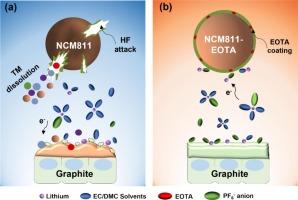一种用于锂离子电池中高电压富镍阴极的浆料添加剂
IF 13.2
1区 工程技术
Q1 ENGINEERING, CHEMICAL
引用次数: 0
摘要
富镍LiNi0.8Co0.1Mn0.1O2 (NCM811)阴极由于其高能量密度而成为下一代锂离子电池(LIBs)的有希望的候选材料。然而,它们的实际应用受到固有挑战的限制,例如在苛刻的循环过程中形成微裂纹,这会破坏阴极-电解质界面的稳定性。这种不稳定性加速了电池容量的退化和过渡金属的溶解,大大降低了电池的使用寿命。为了解决这些问题,我们引入了4-(乙氧基)三甲基丙烯三丙烯酸酯(EOTA)作为多功能浆料添加剂来构建坚固的阴极电解质界面(CEI)层。EOTA添加剂能够在循环过程中在阴极表面原位形成坚固的保护界面层。经综合表征证实,该CEI层有效抑制副反应,减轻结构降解,减少过渡金属溶解。因此,NCM811||Li半电池在4.5 V的高截止电压下实现了快速充电能力,与裸NCM811阴极相比,其容量保持率显著提高。此外,石墨||NCM811完整电池在200次循环后提供了令人印象深刻的87.1 %的容量保留率,而袋状电池在500次循环后保持了79.8% %的容量保留率。本研究提出了一种简单而有效的策略来克服富镍阴极的界面挑战,为开发高性能、长效锂离子电池提供了新的途径。本文章由计算机程序翻译,如有差异,请以英文原文为准。

A functional slurry additive for robust interphase and stabilized high-voltage nickel-rich cathodes in lithium-ion batteries
Nickel-rich LiNi0.8Co0.1Mn0.1O2 (NCM811) cathodes are promising candidates for next-generation lithium-ion batteries (LIBs) due to their high energy density. However, their practical application is limited by inherent challenges, such as microcrack formation during demanding cycling, which destabilizes the cathode-electrolyte interface. This instability accelerates capacity degradation and transition metal dissolution, significantly reducing battery lifespan. To address these issues, we introduce 4-(ethoxy) trimethylolpropane tri-acrylate (EOTA) as a multifunctional slurry additive to construct robust cathode-electrolyte interface (CEI) layer. The EOTA additive enables the in-situ formation of a robust, protective interfacial layer on the cathode surface during cycling. This CEI layer effectively suppresses side reactions, mitigates structural degradation, and reduces transition metal dissolution, as confirmed through comprehensive characterization. As a result, NCM811||Li half-cells achieve fast charging capability at a high cutoff voltage of 4.5 V, with significantly improved capacity retention compared to bare NCM811 cathodes. Additionally, Graphite||NCM811 full cells deliver an impressive 87.1 % capacity retention after 200 cycles, while pouch cells maintain 79.8 % capacity retention after 500 cycles. This study presents a simple yet effective strategy to overcome interfacial challenges in nickel-rich cathodes, providing a new pathway toward the development of high-performance, long-lasting lithium-ion batteries.
求助全文
通过发布文献求助,成功后即可免费获取论文全文。
去求助
来源期刊

Chemical Engineering Journal
工程技术-工程:化工
CiteScore
21.70
自引率
9.30%
发文量
6781
审稿时长
2.4 months
期刊介绍:
The Chemical Engineering Journal is an international research journal that invites contributions of original and novel fundamental research. It aims to provide an international platform for presenting original fundamental research, interpretative reviews, and discussions on new developments in chemical engineering. The journal welcomes papers that describe novel theory and its practical application, as well as those that demonstrate the transfer of techniques from other disciplines. It also welcomes reports on carefully conducted experimental work that is soundly interpreted. The main focus of the journal is on original and rigorous research results that have broad significance. The Catalysis section within the Chemical Engineering Journal focuses specifically on Experimental and Theoretical studies in the fields of heterogeneous catalysis, molecular catalysis, and biocatalysis. These studies have industrial impact on various sectors such as chemicals, energy, materials, foods, healthcare, and environmental protection.
 求助内容:
求助内容: 应助结果提醒方式:
应助结果提醒方式:


